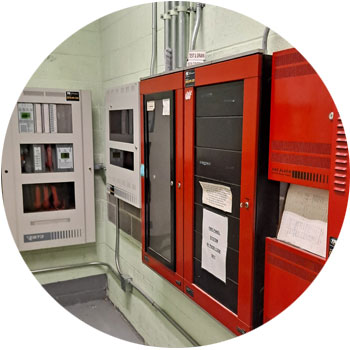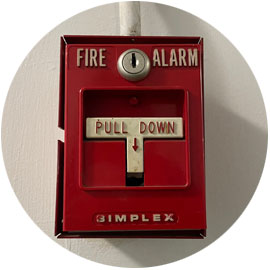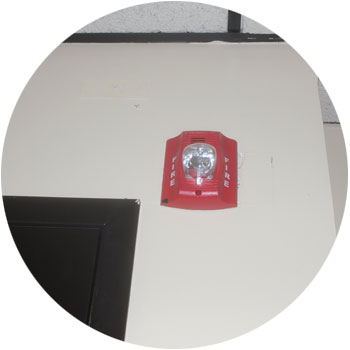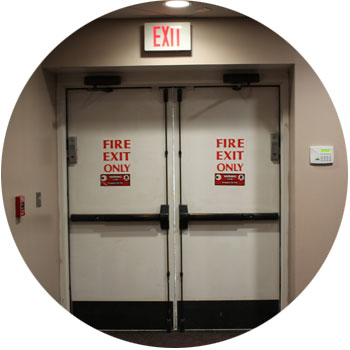Video MGMT System
 Access Control
Access Control
Voice & Data Wiring
 Burglar Alarm
Burglar Alarm
 Fire Alarm
Fire Alarm
Video MGMT System
Voice & Data Wiring
Fire alarm systems use sensors to recognize potential fires, notification appliances to alert emergency services and assist in evacuations, and control panels to manage all of the system's various components.
When a fire alarm sensor is triggered, it sends a signal to its central control panel, which then notifies emergency response teams and activates devices to alert people and help them to evacuate.
There are two main types of fire alarm systems, those with conventional alarm panels and those with addressable alarm panels.
In conventional or traditional fire alarm systems, devices like smoke and heat detectors are connected to a central control panel that monitors and manages the various components of the fire alarm system.
Conventional fire alarms divide monitored areas into zones, with each zone having its own set of fire alarm detectors. This allows the system to identify the general location of a fire, which is extremely helpful when attempting to save people and property in large buildings or complex structures.
Conventional fire alarms are cost-effective, but they require a lot of maintenance and are not as easily scalable as addressable fire alarm systems. Most importantly, while conventional systems do tell emergency personnel which zone an initiating device is in, they aren't able to pinpoint the specific initiating device and its location.

An addressable fire alarm system is often referred to as an "intelligent system" because it uses advanced new technologies for improved reliability and greater user control.
In an addressable system, every fire detection device is assigned a unique address, allowing the control panel to identify and communicate with each device individually and identify the specific location of triggered fire detection devices rather than just provide a status indication for a general zone.
Fire alarm detectors or initiation devices include smoke detectors, heat-sensitive detectors, pull stations, and other types of fire alarm sensors. The purpose of these devices is to detect the presence of fire and trigger alarms to alert people to evacuate.
The types of initiation devices used in fire alarm systems depend on the setting in which the system is installed and the most likely types of fire in that setting. For example, some initiating devices are suited for detecting smoke or flames, while others are better at detecting increases in temperature.
The five main types of fire alarm detectors used in conventional and addressable alarm systems are manual pull-station call points, photoelectric smoke detectors, ionization smoke detectors, heat detectors, carbon monoxide detectors, and multi-sensor detectors.

A manual call point, also known as a pull station, is a hand-operated device that allows building occupants to quickly and easily activate emergency alarms by pulling a handle or hook.
Manual fire alarms are usually red or yellow and are installed in areas that are easily accessible and visible to building occupants.
Ionization smoke detection systems use ionization to detect smoke. They work by using a small amount of Americium-241, a radioactive material, to
They work by creating an ionized electrical current inside a detector chamber using a radioactive material called Americium-241. When smoke enters the chamber, it disrupts the electrical current and triggers the alarm.
Ionization smoke detectors are highly sensitive to small particles of smoke, such as those produced by flaming fires, and they can detect fire at an earlier stage than light-scattering smoke detectors.
Light-scattering smoke detectors, also known as photoelectric detectors, work by shining a light source into a sensor chamber and measuring the amount of light that is reflected back. When smoke enters the chamber, it scatters the light and triggers an alarm.
Light-scattering smoke detectors are more sensitive to larger particles of smoke than ionization detectors. They do an excellent job recognizing smoke produced by smoldering fires and slow-burning materials like tobacco, paper, or wood.
Light-scattering smoke detectors are considered safer than ionization detectors because they don't use radioactive materials. They're also less prone to false alarms from cooking steam and smoke.
Heat detectors are typically installed in areas where smoke detectors may not be practical, such as kitchens. The two main types of heat detectors are fixed-temperature detectors and rate-of-rise detectors.
Fixed-temperature detectors are triggered when the temperature in a monitored area reaches a pre-set level.
Rate-of-rise detectors, on the other hand, are activated when the rate of temperature increase exceeds a certain preset threshold. Rate-of-rise detectors are most useful in areas where a slow, steady increase in temperature is expected.
Combination heat detectors combine the features of a fixed temperature detector and a rate-of-rise heat detector. They're triggered when either the temperature reaches a preset level or the rate of temperature increase exceeds a preset level.
Carbon monoxide (CO) detectors sense the presence of carbon monoxide, an odorless, poisonous gas produced by burning fuels like natural gas, propane, oil, wood, and charcoal. They should be installed in all living and working areas, as well as in areas with fuel-burning appliances.
There are two main types of carbon monoxide detectors, electrochemical CO detectors, and biometric CO detectors. Electrochemical CO detectors use a chemical reaction to detect the presence of carbon monoxide while biometric CO detectors use a sensor that changes based on the level of CO in the air.
Carbon monoxide detectors work in conjunction with fire alarm systems to provide early warnings and assist in prompt evacuations during CO leaks. They should be interconnected with other fire alarm devices so that CO alerts are not limited to a single room or area where an occupant may already be unconscious.
Some fire alarms include special features to enhance the overall performance and functionality of the fire alarm system. The specific features recommended for your fire alarm system will depend on the specific needs of your site, as well as local fire codes and regulations.
The best fire alarms feature remote monitoring capabilities that allow users to check their fire alarm system status from anywhere, receive notifications of alarm events, and work with 24/7 remote monitoring services.
Some fire alarm systems feature voice evacuation capabilities so that clear and concise instructions can be given to building occupants in the event of a fire.
Most fire alarm systems include visual signaling, such as strobes and emergency exit signs, to provide visual notifications of fire emergencies and assist in evacuations.

Multi-sensor alarms use multiple detectors to recognize different signs of danger, such as smoke and heat. Multi-sensor detectors are typically more expensive than single-sensor detectors, but they provide a heightened level of protection and are excellent at reducing false alarms.
For example, if a multi-sensor alarm's smoke detector senses smoke, it may send a signal to a heat sensor, which would then measure the temperature in the area. If the temperature is within a certain range, the detectors will activate the fire alarm system.
The advantage of multi-sensor detectors is that they initiate fire alarms as quickly as single-sensor detectors but with fewer false alarms.
Fire alarm strobes flash lights to visually alert building occupants of a fire emergency and the need to evacuate. These strobes are activated by the fire alarm control panel.
They're usually installed in a building's high-traffic public areas, such as hallways, lobbies, and elevators. They're especially useful because they help people with hearing impairments recognize that there is a fire emergency.

All commercial buildings are required by law to install fire alarms and to have them tested regularly. The specific type of fire alarm or alarms that your business needs depend on factors like the size and use of the building, the potential fire hazards that are present, and local fire codes and regulations.
Most small businesses need smoke detectors and heat detectors, as well as manual fire alarm call points. Apartment building high-rises and industrial manufacturing plants require even more sophisticated fire safety equipment.
It's usually necessary to consult with fire protection professionals, like the experts on our team here at Mammoth Security, to determine which specific alarm devices are best for your business.
The Connecticut State Fire Safety Code holds that all fire alarm systems must be inspected and tested by a licensed inspector at least once every 12 months. Schools, hospitals, and high-rise buildings in Connecticut have to undergo fire alarm inspections every 6 months. Fire alarm systems should also be inspected by licensed fire safety experts after any system modifications, malfunctions, or fire incidents.
It's important to keep accurate records of all fire alarm inspections, tests, and repairs. These records are often required by local fire departments and regulatory agencies.
Fire alarm systems can be integrated with other security equipment by qualified and licensed professionals who are in compliance with professional fire safety standards. Integrating fire alarms with access control, video surveillance, emergency notification, and fire-suppression systems can dramatically improve building safety and reduce response times in the event of a fire emergency.
The most common type of fire alarm is a smoke detector due to its effectiveness and affordability.
The five most common types of commercial fire alarm systems are conventional fire alarm systems, addressable fire alarm systems, wireless fire alarm systems (which we discourage because they are unreliable), manual fire alarms, and automated fire alarms.
The type of commercial fire alarm system that should be installed for your business depends on the specific needs of your site, the fire risk present, and local fire codes and regulations.
A smoke alarm is a type of fire detector designed to sense smoke while a fire alarm, on the other hand, refers to a more comprehensive system that may include smoke alarms, flame detectors, heat detectors, manual initiating devices, notification systems, emergency lighting systems, and a central control panel that manages the individual components of the fire alarm system.

You can trust our team at Mammoth Security to develop and install the right security solutions to protect your commercial property. From alarms and access control to cameras and cabling, we take pride in what we do, and we’d love to share our expertise and workmanship with you.
If you're ready for the next step toward securing your property, fill out the simple form below to set up a free, zero-obligation site consultation. You’ll meet a friendly member of our team as we survey your property, discuss your security concerns, spot points where your security can be improved, and begin to develop a security system that’s expertly tailored to your site’s unique layout and needs.

Wireless
IP Cameras
Wireless cameras are not reliable enough for commercial use yet. Instead, we use purpose-built antennae to connect hardwired cameras on light poles and buildings.

Phone App
For Camera Systems
Watch live or previously recorded footage on any mobile device. Save it to your phone and e-mail it just like any other video or image.

Increased Resolution
Of 4096×2160
4k or 8MP cameras represent the best value at the moment. Depending on your situation, a 30+ megapixel camera can be installed allowing you to read a seat number from the opposite end of a football field.

Employ The Same Technology As These Companies:


